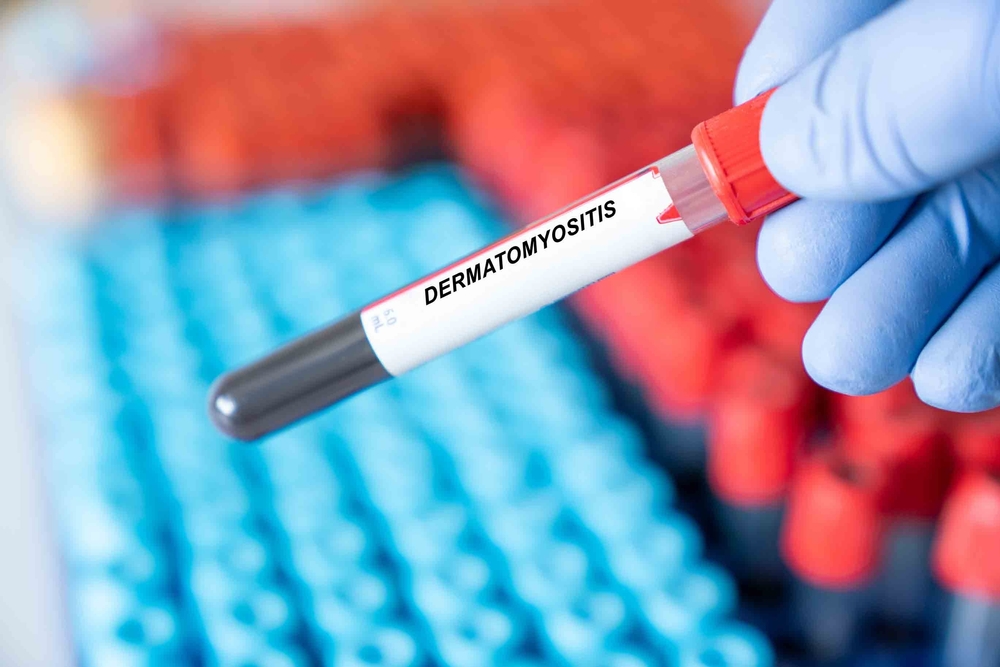Dermatomyositis is a rare inflammatory disease that affects the muscles and skin, often leading to significant discomfort and mobility challenges. While the condition can impact anyone, its early signs are frequently overlooked, delaying diagnosis and treatment. Understanding the symptoms, causes, and treatment options is essential for managing dermatomyositis effectively.

Understanding Dermatomyositis
Dermatomyositis is classified as an autoimmune disease, meaning the body’s immune system mistakenly attacks healthy muscle and skin tissues. It is part of a group of conditions called inflammatory myopathies, which cause chronic muscle inflammation and weakness. Although its exact cause remains unknown, researchers believe a combination of genetic and environmental factors, such as infections and certain medications, may trigger the disease.
The disease can affect individuals of any age but is most commonly diagnosed in adults between the ages of 40 and 60 and in children between 5 and 15. Women are more likely to develop dermatomyositis than men, though both sexes can experience its debilitating effects. More details on the condition, including risk factors and causes, can be found in this comprehensive resource from Mayo Clinic.
Signs of Dermatomyositis That Many Men Tend to Ignore
Men often dismiss early symptoms of dermatomyositis as fatigue or the effects of aging, leading to delays in seeking medical care. Some key signs that men might overlook include:
- Persistent muscle weakness, particularly in the shoulders, upper arms, hips, and thighs
- A red or purplish rash on the face, eyelids, knuckles, elbows, or knees
- Difficulty climbing stairs, lifting objects, or rising from a seated position
- Fatigue and unexplained weight loss
- Swelling or pain in the joints
Because dermatomyositis progresses over time, ignoring these symptoms can lead to more severe complications, such as difficulty swallowing or lung problems. A deeper dive into the symptoms can be found through Cleveland Clinic.
Signs of Dermatomyositis That Many Females Tend to Ignore
While dermatomyositis affects men and women alike, some symptoms may be more frequently disregarded by females due to misattribution to other health issues. Women may mistake muscle weakness for general tiredness or aging, delaying proper diagnosis. Key signs that women should be aware of include:
- A heliotrope rash—purplish discoloration around the eyes
- Gottron’s papules—red, scaly bumps on the knuckles, elbows, and knees
- Hair thinning or brittle nails
- Raynaud’s phenomenon—fingers and toes turning white or blue in response to cold or stress
- Chronic shortness of breath or dry cough
Since dermatomyositis is an autoimmune disease, women with other autoimmune conditions, such as lupus or rheumatoid arthritis, may be at higher risk. Information on how the disease affects different populations can be found at MedlinePlus.
If You Have Dermatomyositis, Do This Immediately
Receiving a dermatomyositis diagnosis can be overwhelming, but taking prompt action can significantly improve quality of life. The first steps after diagnosis include:
- Consulting a rheumatologist or neurologist to create a tailored treatment plan
- Starting corticosteroids or immunosuppressants as prescribed to reduce inflammation
- Beginning physical or occupational therapy to maintain muscle strength and mobility
- Protecting skin from UV exposure, as sunlight can worsen symptoms
- Monitoring for complications such as lung or swallowing issues
Early intervention is critical in preventing muscle deterioration and complications. Further guidance on managing dermatomyositis can be explored through Johns Hopkins Medicine.
Dermatomyositis Is Silent but Deadly (Learn the Signs)
Because dermatomyositis is a progressive disease, failing to recognize the symptoms can lead to severe, even life-threatening, complications. The most dangerous consequences of untreated dermatomyositis include:
- Interstitial lung disease, which causes scarring of lung tissue and breathing difficulties
- Dysphagia (difficulty swallowing), increasing the risk of aspiration pneumonia
- Increased risk of cancer, as some cases of dermatomyositis are linked to malignancies
- Heart complications, including inflammation of the heart muscle (myocarditis)
- Permanent muscle damage, leading to disability
Understanding these risks highlights the importance of early detection and treatment. More information on potential complications can be found at NORD (National Organization for Rare Disorders).
How Dermatomyositis Is Treated
While there is no cure for dermatomyositis, treatment focuses on reducing inflammation, relieving symptoms, and preventing complications. Common treatment approaches include:
- Medications: Corticosteroids such as prednisone are often the first line of treatment. Immunosuppressive drugs may also be used to control immune system overactivity.
- Physical Therapy: Regular exercises help maintain muscle strength and prevent atrophy.
- Skin Protection: Since dermatomyositis causes extreme sensitivity to sunlight, patients are advised to use sunscreen and wear protective clothing.
- Speech and Swallowing Therapy: If the disease affects the muscles involved in swallowing, therapy can help prevent complications.
- Intravenous Immunoglobulin (IVIG): This treatment helps regulate the immune system in severe cases.
Patients with dermatomyositis should work closely with their healthcare providers to determine the best course of action for their specific condition. More details on treatment strategies are available at Muscular Dystrophy Association.
Living with Dermatomyositis
Adjusting to life with dermatomyositis requires lifestyle changes and ongoing medical care. Some strategies to enhance daily living include:
- Eating a nutrient-rich diet to support muscle health
- Engaging in low-impact exercise to maintain flexibility
- Joining support groups for emotional and practical support
- Managing stress to reduce autoimmune flare-ups
- Scheduling regular medical check-ups to monitor disease progression
While dermatomyositis presents significant challenges, early diagnosis and proper management can improve long-term outcomes. Seeking expert care and making necessary lifestyle modifications are key to living well with the condition.




